Related Research Articles

Husband Edward Kimmel was a United States Navy four-star admiral who was the commander in chief of the United States Pacific Fleet (CINCPACFLT) during the Japanese attack on Pearl Harbor. He was removed from that command after the attack, in December 1941, and was reverted to his permanent two-star rank of rear admiral due to no longer holding a four-star assignment. He retired from the Navy in early 1942. The United States Senate voted to restore Kimmel's permanent rank to four stars in 1999, but President Clinton did not act on the resolution, and neither have any of his successors.

The Battle of Leyte Gulf was the largest naval battle of World War II and by some criteria the largest naval battle in history, with over 200,000 naval personnel involved.

William Frederick "Bull" Halsey Jr. was an American Navy admiral during World War II. He is one of four officers to have attained the rank of five-star fleet admiral of the United States Navy, the others being William Leahy, Ernest J. King, and Chester W. Nimitz.
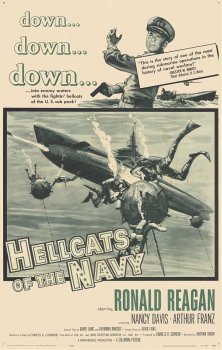
Hellcats of the Navy is a 1957 American black-and-white World War II submarine film drama from Columbia Pictures, produced by Charles H. Schneer and directed by Nathan Juran. The film stars Ronald Reagan and his wife, billed under her screen name Nancy Davis, and Arthur Franz. This was the only feature film in which the Reagans acted together, either before or after their 1952 marriage.
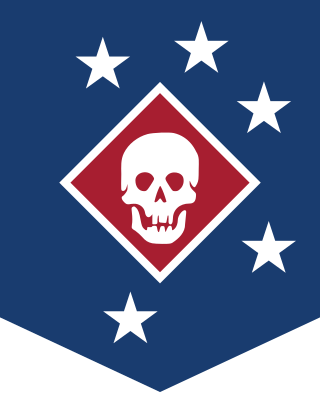
The Marine Raiders are special operations forces originally established by the United States Marine Corps during World War II to conduct amphibious light infantry warfare. "Edson's" Raiders of 1st Marine Raider Battalion and "Carlson's" Raiders of 2nd Marine Raider Battalion are said to have been the first United States special operations forces to form and see combat during World War II.

The United States Third Fleet is one of the numbered fleets in the United States Navy. Third Fleet's area of responsibility includes approximately fifty million square miles of the eastern and northern Pacific Ocean areas including the Bering Sea, Alaska, the Aleutian Islands, and a sector of the Arctic. Major oil and trade sea lines of communication within this area are critically important to the economic health of the United States and friendly nations throughout the Pacific Rim region.
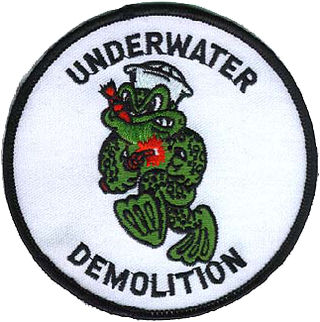
The Underwater Demolition Team (UDT), or frogmen, were amphibious units created by the United States Navy during World War II with specialized missions. They were predecessors of the Navy's current SEAL teams.

This is the order of battle for the Battle of Midway, a major engagement of the Pacific Theatre of World War II, fought 4–7 June 1942 by naval and air forces of Imperial Japan and the United States in the waters around Midway Atoll in the far northwestern Hawaiian Islands.

The Battle of the Coral Sea, a major engagement of the Pacific Theatre of World War II, was fought 4–8 May 1942 in the waters east of New Guinea and south of the Bismarck Islands between elements of the Imperial Japanese Navy and Allied naval and air forces from the United States (U.S.) and Australia.
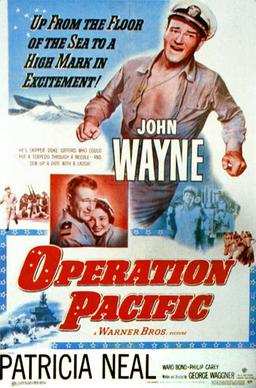
Operation Pacific is a 1951 black-and-white World War II submarine war drama from Warner Bros. Pictures, produced by Louis Edelman, and written as well as directed by George Waggner. John Wayne and Patricia Neal star and Ward Bond and Philip Carey play supporting roles.

Vice Admiral Robert Lee Ghormley was an admiral in the United States Navy who served as commander, South Pacific Area during World War II. Ghormley was long considered to be an ineffective leader–overly cautious, pessimistic, and even defeatist–but recent scholarship has argued that while he may not have been an inspiring leader, he performed well enough under difficult circumstances.
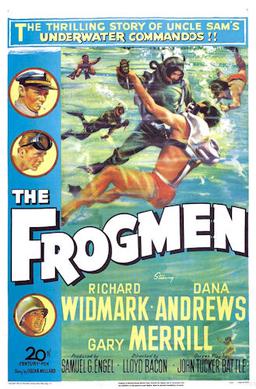
The Frogmen is a 1951 American black-and-white World War II drama film from Twentieth Century Fox, produced by Samuel G. Engel, directed by Lloyd Bacon, that stars Richard Widmark, Dana Andrews, and Gary Merrill. The film's storyline is based on operations by United States Navy Underwater Demolition Teams, popularly known as "frogmen", against the Japanese Army and naval forces. It was the first such film about scuba diving and became a popular cultural hit.

Submarine Command is a 1951 American war film directed by John Farrow and starring William Holden, Don Taylor, Nancy Olson, William Bendix, and Darryl Hickman. It is notable for being one of the first films to touch on post traumatic stress disorder. Holden invested $20,000 of his own money into the film. The film received a mixed reception: it was panned by some critics for its brooding melodrama while being praised by others.

The Atomic Submarine is a 1959 independently made, American black-and-white science-fiction film directed by Spencer Gordon Bennet and starring Arthur Franz, Dick Foran, Brett Halsey, Joi Lansing and Jean Moorhead, with John Hilliard as the voice of the alien. The film was produced by Alex Gordon and distributed by Allied Artists Pictures Corporation.
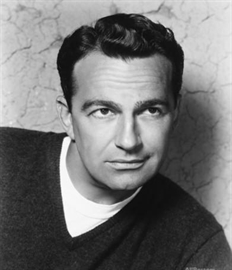
John Bentley was a British film actor. He had a successful career as a leading man from the 1940s to the late '50s and was a popular heart-throb who appeared in many British B-movies during that time. Later in his career, in the 1970s he appeared as Hugh Mortimer, Meg Richardson's ill-fated third husband in the English soap opera Crossroads. He also starred in the jungle adventure series African Patrol (1957) as Chief Inspector Paul Derek and made various other guest appearances in many popular TV series from the late 50s onwards.
Operation Thunderhead was a highly classified combat mission conducted by U.S. Navy SEAL Team One and Underwater Demolition Team 11 (UDT-11) in 1972. The mission was conducted off the coast of North Vietnam during the Vietnam War to rescue two U.S. airmen said to be escaping from a prisoner of war prison in Hanoi. The prisoners, including Air Force Colonel John A. Dramesi were planning to steal a boat and travel down the Red River to the Gulf of Tonkin.

The allied naval bombardments of Japan took place during the last weeks of the Pacific War in 1945, in which warships of the United States Navy, the Royal Navy and the Royal New Zealand Navy bombarded industrial and military facilities in Japan. Most of these bombardments were conducted by battleships and cruisers, and caused heavy damage to several of the targeted factories, as well as nearby civilian areas. A major goal of the attacks was to provoke the Japanese military into committing some of its reserve force of aircraft into battle. However, the Japanese did not attempt to attack the Allied bombardment forces, and none of the involved warships suffered any damage.

For the April 1945 invasion of Okinawa, the Allies assembled the most powerful naval force in history. Since the few remaining capital ships of the Imperial Japanese Combined Fleet had been sunk or otherwise put out of action at the Battle of Leyte Gulf, the Allies were effectively unopposed in terms of major surface vessels; a single mission consisting of the superbattleship Yamato and a few escorts was undertaken, but the task force did not get within 200 nautical miles of the invasion area. The main Japanese naval opposition within the invasion area came from hundreds of Imperial Japanese Navy Shin'yō-class suicide motorboats and Maru-Ni Imperial Japanese Army attack boats.

On 7 August 1942, US and Australian naval forces undertook the invasion of the Japanese-held islands of Guadalcanal and Tulagi in the lower Solomon Islands chain, the first Allied offensive in the Pacific Theatre. The landing of the US 1st Marine Division on the beaches of Savo Sound began the unexpectedly long and extremely arduous Guadalcanal Campaign, lasting officially until 9 February 1943.

On 15 June 1944, United States Marine and Army forces landed on the southwest coast of the island of Saipan in the central Marianas chain. US forces declared Saipan secure on 9 July.